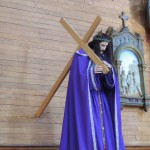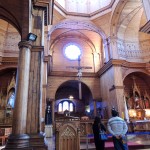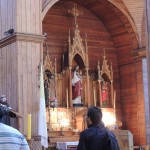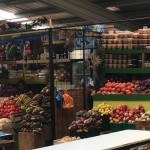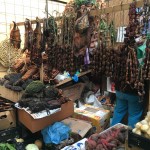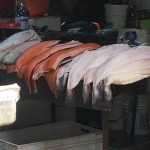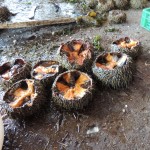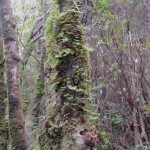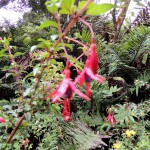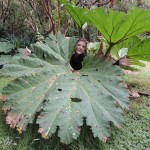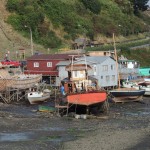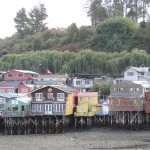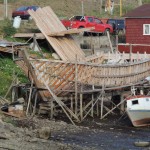
At 7:30 (19:30) on Saturday, John and I waited in the Santiago bus station anticipating a twelve hour ride to Castro, Chiloe’s capital city. Bus travel in SA is easy and inexpensive. Our bus (Cruz del Sur) would be with “coma” meaning the seats recline to almost a flat position. Compare it to first-class air travel.
We arrived in Castro Sunday morning around 10:00. After settling into our room at the hostel, it was time to explore the town.
Chiloe’s wooden churches:
The heart of the town is the church, Iglesia San Francisco de Castro (1912). The Jesuits were responsible for building more than 200 wooden churches in the Chiloe Archipelago. About 60 remain. The Jesuits came to evangelize the indigenous Huilliche people. Castro tour companies conduct all-day tours, daily, to about six of these churches.

Iglesia San Francisco de Castro. Yes, it really is bright yellow and lavender. The inside is all wood. The outside is corrugated metal.
Food:
A few blocks down the hill is the fishing activity. Chiloe’s #1 industry is all aspects of the fish industry. Across from the docks are cafes specializing in the freshest seafood possible. Curanto is the traditional dish of Chiloe. The bowl is piled with various shellfish, sausage, ham hock, potato and a dish called Chapalele (mashed potatoes with cheese mixed together). One person would be hard pressed to eat the entire assembly. The dish costs approximately 5,000 CLP (about $7.00). Traditionally, the meal is cooked in a earthen hole, covered with giant leaves.
The Central Market, popular with the locals, is located at the docks. The market is divided into sections: fish, vegetables, prepared food.
- Fresh vegetables
- The item tied with string are stocks of seaweed
- Salmon is a major fish in this area
- A marisco called Erizo.
- The top is broken off the Erizo and the inside “creature” is scooped out. It’s cooked in a broth.
Parque Nacional Chiloe:
The National Park of Chiloe is an hour’s bus ride from Castro. Entrance fee is 1,500 CLP ($2.20 USD) Seniors get a discount, 750 CLP ($1.10 USD). The Park is divided into three sections. Trekking the top third is very difficult; the middle section slightly easier; and the bottom third is for the rest of us with wooden walkways and well defined paths. Animals were scarce, but the fauna was healthy and interesting.
There is a small museum just inside the park which focuses on Darwin’s visit to Chiloe between 1834-35. The Visitor’s Center displays several maps to help backpackers navigate the park.
Banos (WC’s) are conveniently located around the entrance of the park.
- Tree covered with ferns
- The Chilco flower is pollunated by hummingbirds
- These leaves are really that large!
Outside the main entrance and a short 50′ walk up the road is an obscure gate (no signage), latched only with a chain. Go ahead. At the end of the path is the angry Pacific Ocean.
The Tepu tree has a smooth, cinnamon-colored bark.
Palifito houses:
Palifito, houses on stilts, look like normal houses in the front. But, in the back, they are built over the Ensenada Ahoni (canal). After a day fishing, fishermen would tie their boats to the back porch of their homes. The 1960 earthquake devastated many of the palifito houses. Even though these homes are illegal, no action is taken to take them down. They are a huge tourist attraction.
- When the tide goes out, boat owners are able to do boat repairs.
- Palifito houses. Fishermen would tie their boats to the stilt supports
- Boat Building in slow motion
Most of the Palifito’s have become cafes or hostels. Of all the Palifitos I visited, I didn’t see many boats tied to the back deck. Instead high-end cafes have found that tourists enjoy sitting on the back deck, enjoying a Pisco Sour or Kunstman beer.
Tips for visiting Chiloe:
1. Chiloe isn’t ready for American Prime-Time. There are no Sheraton Hotels, not even a Holiday Inn Express. Not a single Michelin Star shines here. That’s part of the charm of the island. It is rustic. If what you desire is opulence, then book a flight to Paris. This tucked away island isn’t for you. Otherwise, get ready for adventure.
2. If you tire of trying to speak your high school Spanish, try the Palifito, Cafe del Puento Tea Room and Shop, Barrio Palifitos Gamboa. This has become an international respite. While we were there, Italians, French, Swedish and Brits came in for a tea and patisseries. Come for the deserts, not the meals.
Another cafe that has a special tweet, La Brujula del Cuerpo (O’Higgins 308, Plaza de Armas. Facebook: LaBrujulaDelCuerpo). Their ice-cream is made on site and some of the best I’ve ever tasted. They serve traditional Chiloe meals that will give you a good sense of the food of this area. They are open for breakfast and don’t close until midnight.
3. Take a tour. There are multiple tours offered. Most of the tours go to various islands that surround the main island. Select from seeing six of the remaining churches or getting close and personal with Magellanic and Humboldt penguins on Punihuil. Quelcun Tourism is best for tours of the churches.
Our time in Chiloe has come to an end. Tomorrow we travel a short distance to Puerto Montt for a couple of days. Then, the big trip begins on Saturday to Tierra del Fuego (Punto Arenas).



